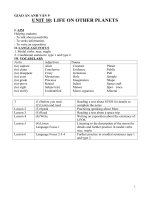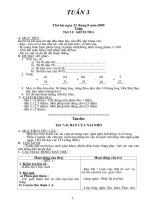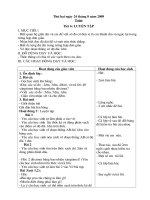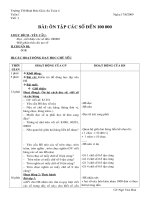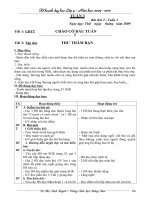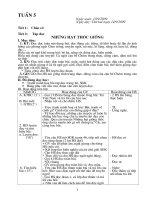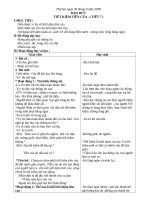giao an - tieng anh9- bai 5- chuan KTKN- hung ne
Bạn đang xem bản rút gọn của tài liệu. Xem và tải ngay bản đầy đủ của tài liệu tại đây (188.12 KB, 18 trang )
Period 27; Week 14
Period 27; Week 14 Date of preparation: September 13
th
, 2008
UNIT 5: THE MEDIA
UNIT 5: THE MEDIA
Lesson 1: Getting started + Listen and read
Lesson 1: Getting started + Listen and read (Page 40-41- 42)
A/ Objectives: After the lesson, students can:
Talk about the media that they know.
Know the history of media in simple ways.
Learn to get access one kind of media for information.
B/ Language content:
1. Vocabulary: (n): media, crier, latest news, remote control, benefit
(a): interactive
(v): income, interact with
2. Grammar: review
3. Language skills: Listening, speaking, reading, writing
C/ Techniques: Picture drill, matching, Questions and Answers,
D/ Teaching aids: Textbooks, cassette player, tape, board,
E/ Procedures:
Stages/ Time Teacher’s activities Students’ activities
Warm-up
Warm-up
(7 minutes)
New lesson
New lesson
(1 minute)
*
*
Getting started: (page 40)
Getting started: (page 40)
- Introduce the topic of the lesson.
Picture drill:
- Ask Ss to look at the pictures on page 40.
- Elicit and explain the new word if necessary.
- Explain the model dialogue.
- Ask Ss to work in pairs to ask and answer about media.
- Call some pairs to practice the dialogues loudly.
- Correct
Suggested answers:
S1: What of these is your favorite activity in your free
time?
S2: Reading newspapers.
S1: How many hour a week do you spend reading
newspapers?
S2: about 4 or 5 hours, I guess.
- Introduce the new lesson.
- Listen T’s introduction.
- Look at the pictures.
- Pay attention and copy down if
necessary.
- Listen carefully.
- Work in pairs.
- Present the dialogues aloud.
- Listen
Presentation
Presentation
(8 minutes)
- Introduce the main content of the “Listen and read”
part.
- Introduce new words:
+ Media (n): ( translation)
+ Latest news (n): ( Explanation)
+ Crier (n): (Picture)
- Listen
- Guess the meaning of the new
words.
+ Remote control (n): (Realia)
+ Interactive (a): (Translation)
+ Interact with (v): ( Example)
+ Benefit (n): ( Translation)
- Guide Ss to read the new words.
- Play the tape two times.
- Ask Ss to read the text silently.
- Read the new words in chorus
and then in individuals.
- Listen to the cassette player.
- Read the text silently.
Practice
Practice
(21 minutes)
* Matching: ( a) page 41).
- Make sure Ss to understand the content in the table of a)
on page 41
- Ask Ss to read passages A,B, C, D and match.
- Have them share the answers with a partner.
- Correct.
Answer key: 1D, 2B, 3B, 4C, 5A, 6D
* Questions and answers: (questions 1,2,3 page 42)
- Make sure Ss to understand the content of questions
from 1 to 3 on page 42 in the textbook.
- Ask Ss to read the text and answer the questions in
pairs.
- Call on Ss to give answers loudly and explain why.
- Give answers.
Answer key:
1. A town crier was a person whose job was to go
through city streets singing a bell to show the latest news
when/ as he was walking.
2. The Kien Thuc Ngay Nay is one of the most popular
magazines and is widely read by both teenagers and
adults.
3. people can get the latest information and enjoy
interesting and inexpensive local and international
programs in a convenient way.
- Read and check in groups.
- Pay attention.
- Read the text and match.
- Exchange the answers.
- Read the answers aloud.
- Pay attention.
- Work in pairs.
- Give answers and explain.
- Copy down.
Production
Production
(5 minutes)
- Ask Ss to answer questions 4 and 5 in b) on page 42 in
groups.
-Call on some representative to show their ideas.
- Correct.
- Answer two questions in
groups.
- Present in front of class.
Consolidation
Consolidation
(2 minutes)
- Summarize the lesson:
+ The history of media
+ Types of media
- Listen and remember.
Homework
Homework
(1 minute)
- Give Ss homework:
1. Do exercises in workbook.
2. Learn Vocabulary and structures by heart.
3. Prepare Speak and Listen
- Take notes.
F/ Self- Evaluation:
……………………………………………………………………………………………………
……………………………………………………………………………………………………
……………………………………………………………………………………………………
……………………………………………………………………………………………………
………………………………………...
Period 28; Week 14
Period 28; Week 14 Date of preparation: September 16
th
, 2008
UNIT 5: THE MEDIA
UNIT 5: THE MEDIA
Lesson 2: Speak and Listen
Lesson 2: Speak and Listen (Page 42- 43)
A/ Objectives: After the lesson, students can:
Develop speaking skill: Express agreement or disagreement about something, express the like or
dislike about programs on TV.
Develop listening skill: listen and fill in the blanks about some invention of media.
Know choosing suitable programs to watch.
B/ Language content:
1. Vocabulary: (n): documentary, telegraph, newsreels, Journalism
(a): informative, violent
2. Grammar: - Tag- questions
3. Language skills: Listening, speaking, reading, writing
C/ Techniques: Brainstorming, board drill, gap- fill,
D/ Teaching aids: Textbooks, cassette player, tape, board,
E/ Procedures:
Stages/ Time Teacher’s activities Students’ activities
Warm-up
Warm-up
(3 minutes)
New lesson
New lesson
(1 minute)
*
*
Brainstorming:
Brainstorming:
- Ask Ss to say: “ the programs on TV”
Suggested words:
+ News
+ Who is millionaire?
+ Weather forecast
+ New life
+ Face to Face
+ Musical games
+ The last guest
+ Ring gold bell
+ We are soldiers
+ Advertisements
+ sports
- Lead to the new lesson.
- Introduce the parts of the new lesson.
- Think and say
- listen.
- Listen carefully.
Pre- speaking
Pre- speaking
(6 minutes)
- Introduce the main content of the “speak” part.
- Introduce new words
+ Violent (a) : (Translation)
+ Documentary (n) : (Explanation)
+ informative(a) : (Explanation)
- Guide Ss to read the new words
- Present the tag- questions. ( formation, use, meaning)
- Give examples to make sure Ss to understand.
- Hang a chart of programs on TV.
- Listen
- Guess the meaning of the new
words.
- Repeat and read in chorus and
in individuals.
- Take notes.
- Pay attention.
- Read it.
While-
While-
Speaking
Speaking
(8minutes)
- Introduce the dialogue in speak.
- Ask Ss to read the dialogue in pairs.
-Call on 2 pairs to read the dialogue loudly.
* Word cue- drill:
- Ask Ss to use the programs in the chart in order to make
the similar dialogues in pairs to talk about the programs
they like or dislike.
- Go around and help if necessary.
- Call on some pairs to practice the dialogues they have
done.
- Check the answers of Ss
- Give answers.
Suggeted answers :
A: You like watching “ Who is millionaire?”, don’t you?
B: Yes, I do. It is informative and I can get some
information from it.
A: You like gardening program, don’t you?
B: no, I don’t. It seem boring to me and I have no time.
- Listen
- Read the dialogue in pairs.
- Read the dialogue aloud.
- Work in pairs.
- Show the dialogues loudly.
- Check the answers with T
- Take notes.
Post -
Post -
speaking
speaking
(9 minutes)
* Write it- up:
- Ask Ss to write a small paragraph about programs they
like or dislike.
- Call on one or two Ss to read their writings loudly.
- Correct.
Suggested answers:
I like watching TV programs. They are useful. I can
learn many things from these programs. They can help me
find solutions to my problem I life. They give me
entertainment after hard working day.
Newspapers are also useful and informative but I don’t
like reading them because I don’t have much free time.
- Write a paragraph
- Read the writings.
Pre- listening
Pre- listening
(4 minutes)
- Introduce the situation of the “listen” part ( Chau, a
student was given an assignment about the inventions of
the media. She needs some information to finish her
assignment. She is asking her father for some information
- Introduce the new words and phrases:
+ Newsreels (n): ( synonym)
+ Telegraph (n): ( translation)
+ Journalism (n): ( translation)
- Guide Ss to read the new words and phrases.
* prediction :
- Ask Ss to guess and fill in the gaps on the table on page
43.
- Write Ss’ prediction on the board.
- Listen
- Guess the meaning of the new
words and phrases.
- Repeat and read in chorus &
one.
- Guess and fill in the gaps.
While-
While-
listening
listening
(10minutes)
- Play the tape two times.
- Have them share the answers with s friend.
- Ask Ss to give their answers.
- Play the tape again and correct the Ss’ answers.
Answers key:
a) The late 19
th
century
b) Radio and newsreels
c) In the 1950s
d) The internet
-Listen and check their guessing.
- Share the answers with a
friend.
- Give answers.
- Listen and check again.
- Take notes.
Post-
Post-
listening
listening
(4 minutes)
* Summary:
- Ask Ss to summarize content of the listen part in groups.
- Call some Ss from each group to answer loudly.
+ For weak Ss: Vietnamese
+ For other Ss : English
- Correct.
- Work In Groups.
- Show their work.
Consolidation
Consolidation
(2 minutes)
- Summarize the lesson:
+ Tag- questions.
+ The inventions of media.
+ The lesson from period (Suitable programs on TV to
watch)
- Listen and remember.
Homework
Homework
(1 minute)
- Give Ss homework:
1. Copy the writings about program Ss like or dislike into
notebooks.
2. Learn Vocabulary and structures by heart.
3. Prepare “Read” part.
4. Write two sentences using Tag questions.
- Take notes.
F/ Self- Evaluation:
……………………………………………………………………………………………………
……………………………………………………………………………………………………
……………………………………………………………………………………………………
……………………………………………………………………………………………………
………………………………………...
Period 29; Week 15
Period 29; Week 15 Date of preparation: September 18
th
, 2008
UNIT 5: THE MEDIA
UNIT 5: THE MEDIA
Lesson 3: Read
Lesson 3: Read (Page 43- 44)
A/ Objectives: After the lesson, students can:
- Develop reading comprehension skill.
- Read and get information about internet.
- Express their opinions about internet.
- Know benefits and disadvantages to control their life.
B/ Language content:
1 .Vocabulary: (n): spam, limitation, forum, electronic junk mail
(v): communicate, get access to, deny, surf, suffer, wander
2. Grammar: review
- Structure: It’s difficult for someone to do something
3. Language skills: Listening, speaking, reading, writing
C/ Techniques: pre- teach, prediction, group work, pair work, questions and answers, write
it- up, chatting
D/ Teaching aids: Textbooks, cassette player, tape, board,
E/ Procedures:
Stages/ Time Teacher’s activities Students’ activities
Warm-up
Warm-up
(5 minutes)
New lesson
New lesson
(1 minute)
*
*
Chatting:
Chatting:
- Ask Ss to answer the questions:
1. Who has already used the internet?
2. Do you think the internet useful or harmful? Or both?
- Introduce the new lesson and the aim of it.
- Answer the questions.
- Listen to teacher.
Pre- Reading
Pre- Reading
(8 minutes)
- Introduce new words:
+ Forum (n): (Translation)
+ Surf (v): ( Example)
+ Deny (v): (translation)
+ Spam (n):(Translation)
+ Limitation (n): ( translation)
+ Wander(v): ( explanation)
+ Get access to (v): (translation)
+ Communicate (v): (translation)
- Guide Ss to read the new words.
- Elicit the structure: “ it is difficult for someone to do
something”
- Set the situation: ( We are listening to forums of friends
about the internet)
- Guess the meaning of the new
words and take notes.
- Repeat and read in chorus and
then in individuals.
- Take notes.
- Listen
While-
While-
Reading
Reading
(20 minutes)
- Play the cassette player two times.
- Ask Ss to read the text silently.
* Questions and answers: ( questions from 1 to 5)
- Make sure Ss to understand the content of questions 1
to 5 on page 44.
- Ask Ss to read the text and answer the questions.
- Ask Them to share the answers with a friend.
- Call on some Ss to give answers.
Answers key:
1. Sandra uses the internet to get information and to
communicate with her friends and relatives.
2. It is difficult for Honghoa to get access to the internet
Because she lives in the countryside, where the internet
is unavailable.
3. People use the internet of education, communication,
entertainment and commerce.
4. The internet is used for multi- purposes: for getting
information, for communication, education,
entertainment, and commerce.
5.Yes, there are some disadvantages: time-consuming,
costly, dangerous because of viruses and bad programs.
- Listen to the tape.
- Read the text silently.
- Listen carefully.
- Read the text and answer the
questions.
- Share the answers with a
friend.
- Read the answers.
- Take notes.
Post- Reading
Post- Reading
(8 minutes)
* Write it- up:
- Ask Ss to answer the questions and write.
1. Do you like the internet?
2. What do you thin of the internet?
- Go around and help if necessary.
- Write
